E-flat blues scale
The Solution below shows the Eb blues scale, on the piano, treble clef and bass clef.
The Lesson steps then explain 2 different ways of constructing this blues scale.
The 1st construction, using the major scale, starts at the First Lesson - 1.
The 2nd construction, using the minor pentatonic scale, is the Final Lesson - 6.
For a quick summary of this topic, have a look at Blues scale.
| Key | C | C# | Db | D | D# | [Eb] | E | E# | Fb | F | F# | Gb | G | G# | Ab | A | A# | Bb | B | B# | Cb |
|---|
Solution
1. E-flat blues scale
The E-flat blues scale has 5 flats.
| Note no. | Note name |
|---|---|
| 1 | The 1st note of the E-flat blues scale is Eb |
| 2 | The 2nd note of the E-flat blues scale is Gb |
| 3 | The 3rd note of the E-flat blues scale is Ab |
| 4 | The 4th note of the E-flat blues scale is A |
| 5 | The 5th note of the E-flat blues scale is Bb |
| 6 | The 6th note of the E-flat blues scale is Db |
| 7 | The 7th note of the E-flat blues scale is Eb |
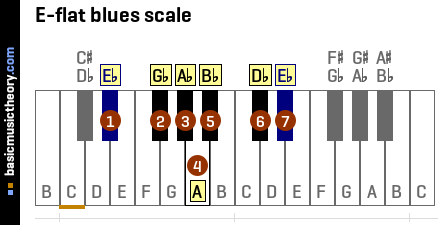
Middle C (midi note 60) is shown with an orange line under the 2nd note on the piano diagram.
These note names are shown below on the treble clef followed by the bass clef.


 Bass Clef
Bass Clef
 Treble Clef
Treble Clef
Lesson steps
1. Piano key note names
The white keys are named using the alphabetic letters A, B, C, D, E, F, and G, which is a pattern that repeats up the piano keyboard.
Every white or black key could have a flat(b) or sharp(#) accidental name, depending on how that note is used. In a later step, if sharp or flat notes are used, the exact accidental names will be chosen.
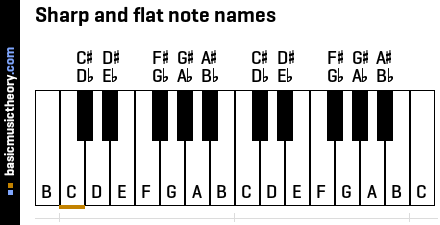
The audio files below play every note shown on the piano above, so middle C (marked with an orange line at the bottom) is the 2nd note heard.
 Bass Clef
Bass Clef
 Treble Clef
Treble Clef
2. E-flat tonic note and one octave of notes
The numbered notes are those that might be used when building this note scale.
Note 1 is the tonic note - the starting note - Eb, and note 13 is the same note name but one octave higher.
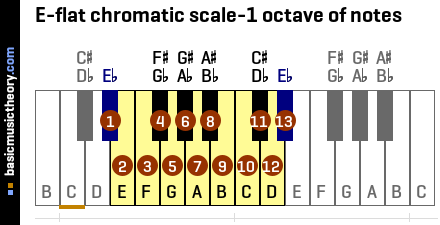
| No. | 1 | 2 | 3 | 4 | 5 | 6 | 7 | 8 | 9 | 10 | 11 | 12 | 13 |
|---|---|---|---|---|---|---|---|---|---|---|---|---|---|
| Note | Eb | E | F | F# / Gb | G | G# / Ab | A | A# / Bb | B | C | C# / Db | D | Eb |
 Bass Clef
Bass Clef
 Treble Clef
Treble Clef
3. E-flat major scale note interval positions
The major scale uses the W-W-H-W-W-W-H note counting rule to identify the scale note positions.
To count up a Whole tone, count up by two physical piano keys, either white or black.
To count up a Half-tone (semitone), count up from the last note up by one physical piano key, either white or black.
The tonic note (shown as *) is the starting point and is always the 1st note in the major scale.
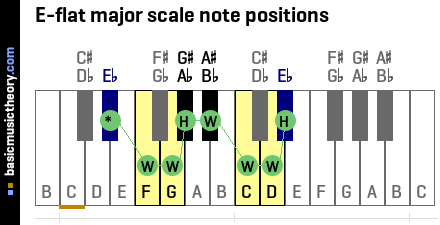
| No. | 1 | 2 | 3 | 4 | 5 | 6 | 7 | 8 |
|---|---|---|---|---|---|---|---|---|
| Note | Eb | F | G | G# / Ab | A# / Bb | C | D | Eb |
 Bass Clef
Bass Clef
 Treble Clef
Treble Clef
4. E-flat major scale notes
Having identified the piano keys that make up this major scale, this step shows the note names of those keys.
| No. | 1 | 2 | 3 | 4 | 5 | 6 | 7 | 8 |
|---|---|---|---|---|---|---|---|---|
| Note | Eb | F | G | Ab | Bb | C | D | Eb |
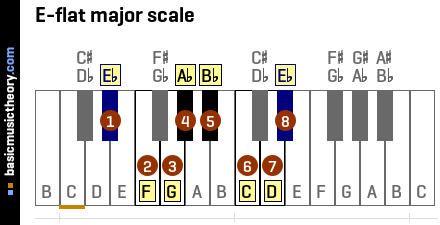
To understand why these sharp and flat note names have chosen given the note positions from the previous step, have a look at the Eb major scale.
 Bass Clef
Bass Clef
 Treble Clef
Treble Clef
5. E-flat blues scale from the E-flat major scale
Structure
The blues scale is made from the 1st, flattened 3rd, 4th, flattened 5th, 5th and flattened 7th notes from the major scale above.The 2nd and 6th notes of the major scale are not used.
To flatten a note, just replace it with the piano key lower in pitch ie. lower down the piano.
Below are those notes numbered 1 to 6 on the piano keyboard.
The 7th note is the octave of the tonic note, where the pattern begins to repeat itself.
Note name simplification
Wherever possible, complex note names from the major scale are simplified to arrive at the final blues scale notes.
For example, in the Gb blues scale, the 4th note of the major scale Cb is simplified to be note B.
This is done because blues (and pentatonic scales) do not follow the 'usual' music theory rules that hold for diatonic scales, such as major and all minor varieties, which state that each note from A..G can only be used once in the scale.
For the blues scale, the half-step / semitone closeness of notes around the 4th and 5th notes usually mean it is inevitable that a note name will be used twice in the scale, so it makes sense to use the chromatic scale names for all notes.
| No. | 1 | 2 | 3 | 4 | 5 | 6 | 7 |
|---|---|---|---|---|---|---|---|
| Note | Eb | Gb | Ab | A | Bb | Db | Eb |

The 4th note is significant in defining the character of the blues scale in comparison to the minor pentatonic scale - see the final lesson step below.
 Bass Clef
Bass Clef
 Treble Clef
Treble Clef
6. E-flat blues scale from the E-flat minor pentatonic scale
The above lesson steps show the blues scale construction using the major scale.
Another construction is to use the notes of the Eb minor pentatonic scale instead.
| No. | 1 | 2 | 3 | 4 | 5 | 6 |
|---|---|---|---|---|---|---|
| Note | Eb | Gb | Ab | Bb | Db | Eb |
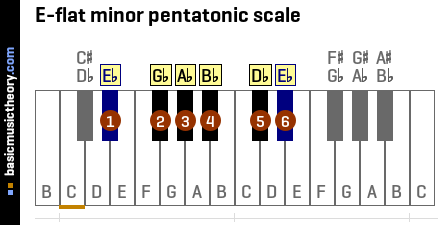
The blues scale is made from taking all notes from the minor pentatonic scale (6 notes), and adding a Diminished 5th note interval based the tonic note - Eb-dim-5th.
This extra 'blue' note - A, which gives the blues scale its distinctive sound, is inserted before the 4th minor pentatonic scale note resulting in the blues scale notes from the previous step:
| No. | 1 | 2 | 3 | 4 | 5 | 6 | 7 |
|---|---|---|---|---|---|---|---|
| Note | Eb | Gb | Ab | A | Bb | Db | Eb |
 Bass Clef
Bass Clef
 Treble Clef
Treble Clef
Related Keys and Topics
| Key | C | C# | Db | D | D# | [Eb] | E | E# | Fb | F | F# | Gb | G | G# | Ab | A | A# | Bb | B | B# | Cb |
|---|